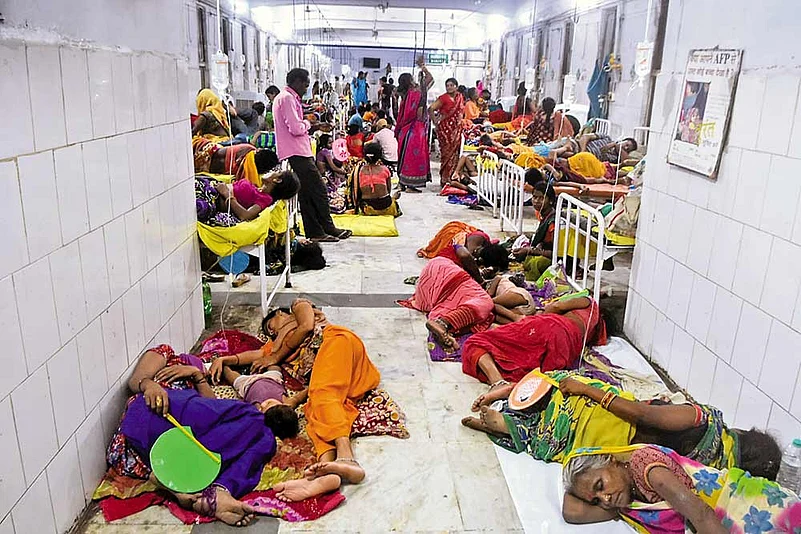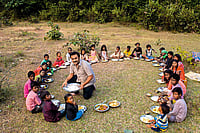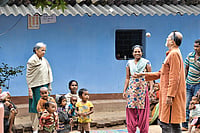There are two children and two sets of parents on every bed. Young mothers cradle limp children. Fathers fuss over immobile babies, barely visible through a maze of tubes and masks. Many more lie on the floor, with parents frantically fanning them to beat the stifling heat. Nurses and doctors run around. Machines blink and glow. High-pitched wailings hush the crowd, sometimes, as little bodies swathed in white are carried out. Or “Wapas jao (go back)” protests ring out as TV anchors or ministers float in and out. But only for a moment. There’s no time to grieve or get angry. The clock is ticking on very sick children.
Time is running out. The shocked nation watches, as heart-wrenching images and stories of suffering from ground zero—Muzaffarpur district in North Bihar—flash across newspapers and television screens. Children are dying like flies every day. A mystery killer is claiming little lives in the blink of an eye: 9 children by June 2, 50 by June 13, 136 by June 20, 170 by June 25. Some 700 children have already been infected across 16 districts in less than a month. Stark statistics are on the wall: it has killed over 60,000 across India in 2010-16, nearly 50 per cent of those who were infected. There’s fear in the air. Hundreds are fleeing villages. The chamki bukhar is running faster and it is winning the race, they say.
Fear without a name
It’s a fear that has no name and no definition: Acute Encephalitis Syndrome (AES) is a basket coinage by the World Health Organisation (WHO) in 2008 for lethal brain fever that hits children hard but remains elusive to doctors and scientists. That’s because, more than 100 different types of viruses, bacteria, parasites and fungi can cause AES symptoms, 50 per cent of the cases are caused by “unknown” agents and 90 per cent have no specific treatment. Hence, patients stay undiagnosed and untreated as the mystery killer sweeps through its territory, counting its victims. If it is not contained soon, India will face an unprecedented situation for which it does not have a plan. “Basket terms are never good in science and AES has turned into a public health conundrum,” says epidemiologist Jayaprakash Muliyil of Christian Medical College, Vellore, a man who has led India’s battle against infections for long. “What is sad is that we have the knowledge base and the technology, yet we have not been able to sort it out. This magnitude of loss is unpardonable. We have lost our priority.”

The outbreak began in the small villages that line the ancient Sarayu river, just as the tall groves of litchi trees lit up with fiery red fruits. Every summer children run around the orchards, play all day long, pick up fruits from the ground, and eat as many as they can. And every summer since 1995, the outbreak flares. Children die painful, unexplained deaths, racked with convulsive seizures, stiff limbed and disoriented—signs of brain inflammation (see graphic). What do they die of? Scientists have not been able to figure out the root cause yet.
The world of science is scanning for evidence. Hypothesis and theories are being reviewed. All stripes of investigating teams have come on board, to carry out field surveys, collect biological samples, probe virological markers. And they are all advocating theories according to their areas of interests. Thickets of medical jargon and numbers are making the shroud of confusion thicker. The litchi is under the scanner. Muzaffarpur, India’s “land of litchi”, supplies the bulk of the country’s harvest and the classiest varieties. To some, it is the toxin, amino acid hypoglycin A, naturally found in litchis, that causes fatal brain inflammation in undernourished children. Don’t lab tests reveal very low blood glucose levels caused by high concentrations of the same amino acids in their body? Litchi scare has hit sales, affecting the very children whose families depend on the fruit for livelihood.
Others point to six-month-old victims. Surely, they couldn’t have eaten litchi? Nothing explains why only some children in a village, or only one in a family, are affected and not the others. Or why, even in July in earlier years, when all the litchis have been harvested, AES cases still continue in Muzaffarpur? With Bihar spending a mere Rs 348 per person per year on healthcare—less than half the national average of Rs 724—primary and community health centres often do not work and treatment facilities are not available at places where cases occur the most. About 91 per cent deaths are believed to happen because the patient travels for over an hour to reach a hospital, say yet others. Some point to pollution, ground water contamination and heat stroke, all adding to the burden of severe malnutrition, immune deficiency and depressed metabolic rates. Increasingly, a viral explanation for the fatal illness in children is gaining ground.
A Boy Who Gorged On Litchis
Jahid, 4, Village Bishnupur Chandtola Muzaffarpur district

Jahid’s mother outside her house with her younger child.
Sudden Onset: Idrish, a mason, and his wife Rehan lost their son to AES. Jahid had taken his dinner and gone to bed. Around 4:30 am, he developed high fever. His parents took him to Muzaffarpur’s Sri Krishna Medical College. There was some delay as roads had been dug up and there was no conveyance nearby. He was immediately taken to the ICU, but was declared dead after three hours.
The Mystery: How did Jahid die? His parents say he had not started school and spent his days playing with his four siblings and cousins in and around litchi orchards, just a stone’s throw from their thatched hut, every day. He may have picked up fruits and eaten them. Apart from the delay in reaching the hospital, was there anything at work?
Call For Investigation: A possible explanation could be that fruit-bearing litchi trees attract bats, known to be a reservoir of AES pathogens. Eating litchis that are contaminated with bat excreta can lead to infection. The most common cause of encephalitis, however, is the arbovirus, which is transmitted through insect bites. Jahid may have been bitten by mosquitoes and sandflies, which thrive near litchi trees and feed on bats, and gotten infected.
India under siege
Even as Bihar struggles to contain the outbreak, 16 children have died of AES in neighbouring Uttar Pradesh. Rajasthan has directed health officials to stay on alert against sporadic cases it has witnessed since 2016. Doctors at Kolkata and Kozhikode are warning of rising encephalitis cases from an atypical source, while Mizoram has been in the grip of an outbreak since January. Karnataka’s Shimoga district is still reeling from the deadly encephalitis triggered by a little-known virus. According to the National Vector Borne Diseases Control Programme (NVBDCP), AES cases have occurred typically in the rice-belts of Assam, Uttar Pradesh, West Bengal, Odisha, Tamil Nadu, Karnataka, Manipur, and Tripura so long. But in 2018, about 10,485 cases have taken place across 17 states, shows NVBDCP data. AES is clearly spreading its tentacles across India.
As scientists find ways to combat a pathogen in the AES basket, new ones come up to claim more lives. The first case of AES was reported in India in 1955 from Vellore, Tamil Nadu, and the first major outbreak in 1973 from Bardhaman district of West Bengal. Since then, AES and Japanese Encephalitis Virus (JEV) have been reported from 171 districts of 19 states. But after the introduction of a JEV vaccine in 2005 and launch of surveillance guidelines by the NVBDCP, cases have come down. “Once the incidence of JE falls, AES caused by other neuropathogenic agents are unmasked,” says Dr Rajnish Joshi of AIIMS Bhopal.
That’s what has happened. Coming to the fore since the 2000s is a host of microbes: Herpes Simplex virus, Enterovirus, Nipah virus, Chandipura virus, Scrub Typhus bacteria, West Nile Virus, the Kyasanur Forest Virus. Most of these have not been seen as outbreaks affecting a large population in this country. The mechanisms that regulate them or the vectors they use for transmission are not understood enough. Most are not taught in medical schools. There are no clinical guidelines for doctors on these. What’s more, there is very little immunity against them in general population. Hence, they pose a much more deadly threat in the future. “Many of these outbreaks occur in hot and humid seasons, predominantly affect children, and have a high case-fatality,” adds Joshi. But in absence of a definite viral diagnosis for each, it is very difficult to treat patients, he explains. This conquest of new territories by AES and its newer forms imply that new risks have now to be taken into account. And India will now have to live with that threat.
Viruses, parasites and bacteria that prey on humans are microscopic predators, called pathogens. They cause infectious diseases and spread from one person to another through food, touch, air and water. Some spread from the environment, through animals. Within AES, different pathogens follow different routes, but all affect the human central nervous system (CNS), can cause serious complications and death—children being at highest risk because of their immature immunity. Those who survive often end up with neurological, physical and psychological consequences.

A child showing AES symptoms being treated in Muzaffarpur.
Viruses are believed to form a significant proportion of AES in children. Their actual contribution, however, is not entirely known, because other causes—from benign tumours, cerebral malaria, several disorders of the central nervous system to the “unknown” causes—mimic AES. Studies have reported central nervous system involvement among a substantial number of scrub typhus bacteria in patients from Dehradun, Vellore, Puducherry and Lucknow, explains Dr Manoj V. Murhekar, director of the National Institute of Epidemiology, Chennai. The bacterial malady transmitted by a microscopic mite has been found to be an important cause of AES in Bihar last year, for the first time. “Policy makers should consider investigations for scrub typhus as part of the surveillance algorithm for AES cases,” Murhekar adds.
Viral pathogens behind AES, however, are much more lethal compared to the non-viral. What is known about them? JEV is an arbovirus, transmitted to humans by insects—typically, the culex mosquito. The Chandipura Virus (CHPV) is a rhabdovirus, a poorly characterised new virus that is, that mutates incessantly—making it particularly lethal. CHPV is transmitted by sand flies and culex mosquitoes. Bats are reservoir of many highly infectious AES pathogens: Nipah virus and West Nile virus to Kyasanur forest disease virus. Herpes Simplex Virus, the most common cause of AES among children in Eastern India, spreads person-to-person. Enteroviruses, increasingly recognised as an important pathogen for AES, spread via water, food and soil. Rotavirus, the prime culprit behind the daily deaths from diarrhoea among children, can also cause hypoglycaemia (extremely low sugar in blood) and convulsions. And, despite the 1.2 lakh diarrhoeal deaths among children every year, Bihar is still to introduce the free rotavirus vaccine.
None Of The Usual Suspects
Rabina Kumari, 4, Village Manika Bishunpur Muzaffarpur district

Rabina’s family in Manika Bishunpur.
Sudden Onset: Rabina had taken dinner as usual and gone to bed. Around 3 am, her parents noticed that she was shivering with high fever. They took her to the local ojha (quack) first. Seeing no improvement, they took her to the Sadar Hospital and from there, to Muzaffarpur’s Sri Krishna Medical College. She was declared brought dead.
The Mystery: It’s a mystery how four-year-old Rabina Kumari contracted AES and died. Born to Chunchun Devi and Chulhai Ram, a casual labourer earning Rs 200-250 a day, Rabina did not go to school, have litchis, bathe in local waterbodies, play with domestic animals or defecate in the open. She also did not skip dinner the day before. The possible explanations of litchi toxin, heat stroke, contamination or malnourishment do not apply to her case, though she received delayed care.
Call For Investigation: AES from scrub typhus virus (O. tsutsugamushi). Since 2016, researchers have linked AES outbreaks in Assam, Mizoram, Gorakhpur and Odisha with this emerging infection. In May 2013, entomologists from the Centre for Medical Entomology and Vector Management, NCDC, Delhi, surveyed the Mushahari block and found houses in all villages infested with rodents and parasites like rat flea, chigger mites, ticks and lice—all established scrub typhus vectors.
Tinkering with nature
The biggest challenge lies elsewhere. As the viral theory gains ground, AES becomes a spectrum of zoonotic diseases, where the pathogen jumps species and is transferred from animals to humans. In the 21st century, zoonotic diseases have caught the world unprepared: from the Severe Acute Respiratory Syndrome (SARS) to the Avian Influenza, the Acute Respiratory Syndrome from Nipah virus, Swine Flue, MERS, Kendra to Ebola and Zika—every global epidemic has been a zoonotic disease. Armed with a host of emerging viruses, they are rising: over one billion and more cases of zoonotic disease are estimated to occur among humans every year, reports the WHO. About 60 per cent of the roughly 400 emerging infectious diseases since 1940 have been zoonotic.
The warning signs have been there. Forest cover in Bihar came down sharply after bifurcation with Jharkhand in 2000, and stood at a poor 7.23 per cent. Even now, the state is a long way off from the desired mandate of 33 per cent. Muzaffarpur was known for its forests and wildlife once. The district is completely devoid of any forest now. “With continuous extension of the area under cultivation, wild buffaloes, gazelle, deer and tiger have disappeared,” reports a 2016 central government report. The only wild animals sometimes seen are the fox and the jackal, besides nilgais and wild boars. Rampant construction of roads and dams, commercial plantations, indiscriminate and illegal sand mining by the “balu mafia” has narrowed down the width of most rivers: the Sarayu is a haunt of smugglers.
Tinkering with nature has made the Muzaffarpur area particularly vulnerable to infectious zoonotic diseases. These diseases appear in areas that have gone through large-scale change in land use and human activity, leading to ecological degradation. Infections spread fast here, because wild life—carriers of some of the viruses—move closer to humans. In case of AES, fruit bats have migrated in thousands to the edges of villages, cities and towns in search of food, and started living in litchi orchards, in close proximity to humans—as with the Ebola and the Nipah outbreaks. “The virus spread from animal faeces, fluids, infected fruits, meat, milk or water,” says Nina Sengupta, ecologist and biodiversity conservation consultant, Pondicherry. “Children gorging on litchis can easily pick up fruits contaminated by the saliva, urine, or guano of bats.” Bats host more than 60 human-infecting viruses—including the Ebola and Nipah viruses, which cause deadly brain fevers in people. Wading birds are the natural maintenance hosts of many of the AES viruses, pigs are known to be the main amplifying hosts, while mosquitoes and sandflies, that thrive near litchi trees and feed on bats, are the primary vectors, she explains.
Others point to ground water contamination with faeces in open-defecation villages. “Several enteroviruses, primarily spread by faecal-hand-oral contamination, are known to cause fatal encephalitis in children,” says Dr Pratip Kundu, director of the Calcutta School of Tropical Medicine. In Bihar, the groundwater in many of the villages has been found to be 35.7 times more at risk of faecal contamination, according to a UNICEF 2019 study. Shallow wells and hand pumps contaminate drinking water with faecal matter are also a major problem in Bihar. A recent study by Girish Kumar Singh, director of AIIMS, Patna, uses virus-tracking software to show how open defecation flows into the Sarayu river in Muzaffarpur, Bihar, down the Gandak river in Gorakhpur, Uttar Pradesh, causing AES in that area. Muzaffarpur is also well-known for using human faeces as fertilisers in litchi orchards. Scientists are now linking the AES deaths to unhygienic conditions of households and rodent infestation. Rats carry parasites, like, rat flea, chigger mites, ticks and lice—all established scrub typhus vectors.
His Home Had No Toilets
Dilip Kumar, 3, Village Khor Patti Muzaffarpur district

Dilip’s parents outside their house in Khor Patti.
Sudden Onset:Dilip had complained of stomach pain for three days. His father, Dinesh Ram, a daily-wage labourer, took him to the local doctor. The prescribed tonic did not help. He suddenly developed high temperature around 4 am. When Dinesh reached SKMCH, 20 km away, the doctors tried to treat Dilip, but he soon died.
The Mystery:The mud and thatched tenement where Dilip lived shows signs of poor domestic hygiene. And like almost the entire village, the family defecates in the open for lack of toilets.
Call For Investigation: Open defecation raises chances of groundwater contamination with enteroviruses, notorious for causing fatal encephalitis in malnourished children. A recent study by Girish Kumar Singh, director of AIIMS, Patna, uses virus-tracking software to show how excrement flows into the Saryu river in Muzaffarpur, Bihar, and down the Gandak river in Gorakhpur, Uttar Pradesh, causing AES in those areas. In Muzaffarpur, people commonly use human faeces as a fertiliser in litchi orchards.
Panic button
AES and the dying children of Bihar have evoked sharp reaction from all quarters. There is finger-pointing at India’s creaking healthcare—the stench of urine, chlorine, vomit, the dearth of health workers and absence of basic provisions at district hospitals. Senior doctors are being suspended for “negligence”. Protest marches are being organised against government “apathy”. Muzaffarpur-based Dr Arun Shah of the Indian Association of Paediatrics has touched a raw nerve by pointing a finger at chief minister Nitish Kumar for not implementing guidelines drafted in 2015 to prevent future attacks: “Anganwadi and ASHA workers were supposed to spread awareness. Instead they were busy with election duties.”
Bihar minister of health Mangal Pandey, who initially refuted reports of children dying of AES in Muzaffarpur, has had to backtrack in face of intense criticism, visit the hospital and announce six ambulances for the institute and enhancing its ward capacity to 100. Union health and family welfare minister Harsh Vardhan has been criticised for reiterating his 2014 proposal of building a virology laboratory in Muzaffarpur, still a promise. Protests greeted Nitish Kumar when he visited AES patients to review the situation. What’s more, the epidemic has sparked a debate over Prime Minister Narendra Modi’s free healthcare scheme for the poor, Ayushmann Bharat, launched in 2018.

A ward of the Sri Krishna Medical College and Hospital, Muzaffarpur, on June 21.
A public interest litigation has been filed at the Supreme Court by an advocate, Manohar Pratap. It claims that the measures taken by the Bihar government are inappropriate and inadequate to control the outbreak in Muzaffarpur. It is also seeking appropriate directions from the court to the state as well as to the Centre for ensuring necessary medical equipment and support for the effective treatment of children suffering from encephalitis. In response to an FIR lodged by social activist Tamanna Hashmi, the chief judicial magistrate of Muzaffarpur has ordered an investigation against Vardhan and Pandey, on grounds of negligence.
In the heat of the moment it has gone out of collective memory that India has successfully coped with the highly contagious avian flu and swine flu outbreaks. AES is, unfortunately, dangerous, expensive and time-consuming. The spectrum of pathogens and the diseases they can unleash needs better surveillance and research, hospitals need not just add beds but also expensive machinery, apart from more staff to treat the sick, more efforts are needed to understand patient history and symptoms. That involves complex assays, blood tests and culture, oxygen and intravenous drips, lumber puncture, neuroimaging facilities like EEG, MRI and CT scan, which do not come cheap.
Does India have a choice? There’s a devastation waiting to happen anywhere and everywhere. And the bad news is: time is seriously running out. The cost of not combating AES on war-footing will be far greater than any cost of preparation. As Muliyil says, “It’s like the Mumbai floods. We have both the knowledge and the know-how to avoid the dangers, but we won’t do it. Somewhere, I hope better sense prevails. And the system finds a solution”.
***
AES In India
1,25,030 cases between 1978 and 2011. Cause of 68-75% unknown
2014
- Cases: 10,867
- Deaths: 1,719
2015
- Cases: 9,854
- Deaths: 1,210
2016
- Cases: 11,651
- Deaths: 1,301
2017
- Cases: 3,558
- Deaths: 279
2018
- Cases: 11,388
- Deaths: 636
Source: The National Vector Borne Diseases Control Programme (NVBDCP)


























